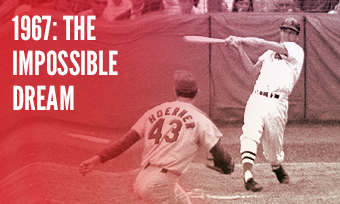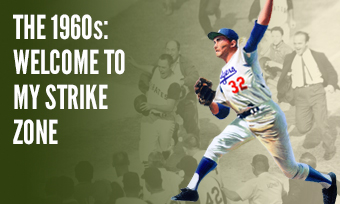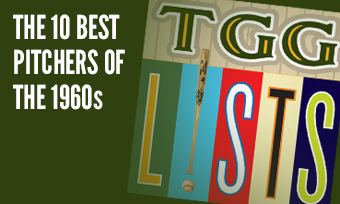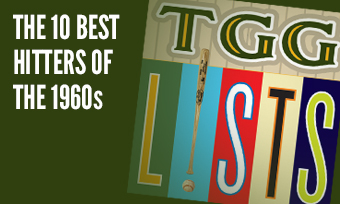The Yearly Reader
Leaders and Honors, 1967
Our list of baseball’s top 10 hitters and pitchers in both the American League and National League for the 1967 baseball season, as well as the awards and honors given to the game’s top achievers of the year.
The National League’s Top 10 Hitters, 1967
Bold type in brick red indicates league leader.
1. Hank Aaron, Atlanta
Key Numbers: .307 average, 113 runs, 184 hits, 37 doubles, 39 home runs, 109 RBIs, 17 stolen bases, .573 slugging percentage.
Hammerin’ Hank was very much enjoying his new home in Atlanta; he hit .350 with 23 of his home runs at Atlanta-Fulton County Stadium.
2. Roberto Clemente, Pittsburgh
Key Numbers: .357 average, 103 runs, 209 hits, 26 doubles, 10 triples, 23 home runs, 110 RBIs.
Clemente won his fourth and final batting title while, for the third of six straight years, he accrued baseball’s version of the triple-double: Double figures in doubles, triples and homers.
3. Richie Allen, Philadelphia
Key Numbers: 122 games, .307 average, 89 runs, 31 doubles, 10 triples, 23 home runs, 77 RBIs, 75 walks, 20 stolen bases, .404 on-base percentage.
Allen had his season cut short when he badly cut his hand on a broken headlight while pushing his car.
4. Orlando Cepeda, St. Louis
Key Numbers: .325 average, 91 runs, 183 hits, 37 doubles, 25 home runs, 111 RBIs, 23 intentional walks, 12 hit-by-pitches, 11 stolen bases.
No longer having to compete with Willie McCovey for the starting first-base job in San Francisco, Cepeda became the first unanimous choice for the NL MVP with St. Louis.
5. Ron Santo, Chicago
Key Numbers: .300 average, 107 runs, 176 hits, 31 home runs, 98 RBIs, 96 walks, 12 sacrifice flies.
The perennial All-Star third baseman could have doubled as the Cubs’ most loyal lobbyist in keeping lights out of Wrigley Field; for the fourth straight year, he hit at least 30 homers, with 124 in total—103 during day games.
6. Jim Wynn, Houston
Key Numbers: .249 average, 102 runs, 29 doubles, 37 home runs, 107 RBIs, 74 walks, 137 strikeouts, 16 stolen bases.
The Toy Cannon hit the most home runs by an Astro until Jeff Bagwell’s strike-year splurge of 1994; one of them cleared Cincinnati’s Crosley Field, landing on an off-ramp from Interstate 75 behind the ballpark.
7. Jim Ray Hart, San Francisco
Key Numbers: .289 average, 98 runs, 167 hits, 26 doubles, 7 triples, 29 home runs, 99 RBIs, 77 walks.
With Orlando Cepeda gone, Willie Mays in decline and Willie McCovey yet to peak, Jim Ray Hart finally got a healthy share of the Giants’ spotlight.
8. Lou Brock, St. Louis
Key Numbers: .299 average, 689 at-bats, 113 runs, 206 hits, 32 doubles, 12 triples, 21 home runs, 76 RBIs, 52 stolen bases, 18 caught stealing.
Once misdiagnosed as a power threat by his first team (the Cubs), Brock muscled up and hit a career-high 21 home runs to go with the more anticipated high numbers in runs, hits, triples and steals.
9. Willie McCovey, San Francisco
Key Numbers: 135 games, .276 average, 31 home runs, 98 RBIs, 71 walks.
Chronically sore knees didn’t keep McCovey from maintaining his standing as one of the NL’s most feared power threats.
10. Billy Williams, Chicago
Key Numbers: .278 average, 92 runs, 176 hits, 21 doubles, 12 triples, 28 home runs, 84 RBIs.
For the only time in a six-year stretch (from 1965-70), Williams did not lead or co-lead the NL in games played, because the Pirates’ Bill Mazeroski managed to squeeze in a 163rd game, one ahead of Williams.
The American League’s Top 10 Hitters, 1967
1. Carl Yastrzemski, Boston
Key Numbers: .326 average, 112 runs, 189 hits, 31 doubles, 44 home runs, 121 RBIs, 91 walks, 10 stolen bases, .418 on-base percentage, .622 slugging percentage.
Yastrzemski gave the AL its second triple crown hitter in as many years; there wouldn’t be another in either league until 2012.
2. Harmon Killebrew, Minnesota
Key Numbers: .269 average, 105 runs, 44 home runs, 111 RBIs, 131 walks, 15 intentional walks, 8 sacrifice flies.
In a year of memorable long-distance homers—see Jim Wynn and Frank Howard, elsewhere on this list—Killebrew launched the longest in Metropolitan Stadium history, at 522 feet.
3. Frank Robinson, Baltimore
Key Numbers: 129 games, .311 average, 83 runs, 23 doubles, 7 triples, 30 home runs, 94 RBIs, 71 walks.
Following up on his triple-crown performance of 1966, Robinson was cruising along toward a potential second such effort—hitting .337 with 21 home runs and 59 RBIs at the end of June—when he suffered a concussion trying to break up a double play. He missed a month and later claimed he was never the same.
4. Al Kaline, Detroit
Key Numbers: 131 games, .308 average, 94 runs, 28 doubles, 25 home runs, 78 RBIs, 83 walks.
Kaline’s otherwise-superb season was cut short by a month when he broke his right hand trying to angrily jam a bat back into the batting rack.
5. Tony Oliva, Minnesota
Key Numbers: .289 average, 76 runs, 161 hits, 34 doubles, 6 triples, 17 home runs, 83 RBIs, 11 stolen bases.
The Twins star kicked into high gear down the stretch, batting .333 over his final 68 games—but it wasn’t enough to compensate for a slow start, leading him to finish below .300 for the first time in his four-year career to date.
6. George Scott, Boston
Key Numbers: .303 average, 75 runs, 171 hits, 21 doubles, 7 triples, 19 home runs, 82 RBIs, 10 stolen bases.
The king-sized Scott left the power to Yastrzemski and sacrificed homers for batting average after a .245 rookie average in 1966, all while battling Dick Williams’ weight guidelines.
7. Don Mincher, California
Key Numbers: .273 average, 81 runs, 25 home runs, 76 RBIs, 69 walks.
Angels fans were focusing on Jimmie Hall as the prime catch in the trade that sent ace Dean Chance to Minnesota, but Mincher proved to be the deal’s most valuable asset in Anaheim.
8. Bob Allison, Minnesota
Key Numbers: .258 average, 21 doubles, 6 triples, 24 home runs, 75 RBIs, 74 walks.
Good comeback effort for Allison, who hit just .220 with eight homers in limited action the year before.
9. Bill Freehan, Detroit
Key Numbers: .282 average, 20 home runs, 74 RBIs, 73 walks, 15 intentional walks, 20 hit-by-pitches.
The evolving catcher led the AL in getting on base the easy way (intentional walks) and the hard way (hit batsmen).
10. Frank Howard, Washington
Key Numbers: .256 average, 20 doubles, 6 triples, 36 home runs, 89 RBIs, 155 strikeouts.
Senators manager (and former Brooklyn Dodgers slugger) Gil Hodges suggested that Howard use more an upper-cut in his swing. The advice made Howard a monster, nearly doubling his home run count from the year before—with one of his blasts measured at 535 feet, the longest in RFK Stadium history.
The National League’s Top 10 Pitchers, 1967
1. Gaylord Perry, San Francisco
Key Numbers: 2.61 ERA, 15 wins, 17 losses, 37 starts, 293 innings, 84 walks, 13 wild pitches, 28 grounded into double plays.
In one stretch, Perry racked up 40 straight consecutive scoreless innings—third longest in Giants history, and a streak he would match in 1970—but despite a better ERA than teammate Mike McCormick, he was the one who ended up with the losing record an no Cy Young Award plaque. (The Giants supported him with only 3.4 runs per start, so there’s your big clue.)
2. Jim Bunning, Philadelphia
Key Numbers: 2.29 ERA, 17 wins, 15 losses, 40 starts, 6 shutouts, 302.1 innings, 73 walks, 20 intentional walks, 253 strikeouts, 13 hit-by-pitches, 23 stolen bases allowed.
Bunning lost five 1-0 decisions—hence, great ERA, modest record.
3. Phil Niekro, Atlanta
Key Numbers: 1.87 ERA, 11 wins, 9 losses, 9 saves, 46 appearances, 20 starts, 207 innings, 19 wild pitches, 21 stolen bases allowed.
Niekro and his knuckleball came into their own, though the joke in Atlanta was that his beleaguered catchers, not he, needed four days’ rest between his starts.
4. Ferguson Jenkins, Chicago
Key Numbers: 2.80 ERA, 20 wins, 13 losses, 38 starts, 20 complete games, 289.1 innings, 15 caught stealing/picked off.
Memo to the Phillies, who traded away the future in Ferguson Jenkins to win “now” in 1966: In 1967, the future was now in Chicago.
5. Claude Osteen, Los Angeles
Key Numbers: 3.22 ERA, 17 wins, 17 losses, 39 starts, 288.1 innings, 52 walks, 15 caught stealing/picked off, 32 grounded into double plays.
A lot of opponents were sacrificing themselves against Osteen; no National League pitcher gave up more sac bunts and sac flies.
6. Bill Singer, Los Angeles
Key Numbers: 2.64 ERA, 12 wins, 8 losses, 32 appearances, 29 starts, 204.1 innings.
The 23-year-old rookie righty did well enough in an impossible mission: To fill the void left behind by the retired Sandy Koufax.
7. Mike McCormick, San Francisco
Key Numbers: 2.85 ERA, 22 wins, 10 losses, .688 win percentage, 40 appearances, 35 starts, 262.1 innings, 81 walks.
It seemed just a matter of time before Juan Marichal won a Cy Young Award, but as he slumped in 1967, McCormick—back with the Giants after an unsuccessful four-year tour of the American League—ended up grabbing the honor.
8. Bob Gibson, St. Louis
Key Numbers: 2.98 ERA, 13 wins, 7 losses, 24 starts, 175.1 innings, 40 walks.
Only once between 1965-70 did Gibson fail to win 20 games—and that one time came in 1967 when a broken leg in mid-July ruined what looked to be solid momentum toward reaching the milestone. However, he did begin a record run of 26 straight quality starts (six or more innings, three or fewer earned runs allowed).
9. Chris Short, Philadelphia
Key Numbers: 2.39 ERA, 9 wins, 11 losses, 29 appearances, 26 starts, 199.1 innings.
Short began a streak of 25 straight starts in which he gave up three or fewer runs—and yet he still won just nine games.
10. Dick Hughes, St. Louis
Key Numbers: 2.67 ERA, 16 wins, 6 losses, .727 win percentage, 3 saves, 37 appearances, 27 starts, 222.1 innings, 48 walks.
Hughes’ standout substitution for Bob Gibson wasn’t bad for a guy who would win four total games over two other major league seasons.
The American League’s Top 10 Pitchers, 1967
1. Joe Horlen, Chicago
Key Numbers: 2.06 ERA, 19 wins, 7 losses, .731 win percentage, 35 starts, 6 shutouts, 258 innings, 58 walks.
Pitchers pined to emulate Horlen’s success—including a September 10 no-hitter against the Tigers—but not his habit of chewing on tissues (tobacco made him sick).
2. Gary Peters, Chicago
Key Numbers: 2.28 ERA, 16 wins, 11 losses, 36 starts, 260 innings.
In a superb follow-up to his ERA-winning campaign of 1966, Peters’ most curious outing of 1967 was an 11-inning stint against Cleveland in which he allowed no runs, just one hit—and 10 walks—while getting no decision in the White Sox’ 1-0, 17-inning victory.
3. Dean Chance, Minnesota
Key Numbers: 2.73 ERA, 20 wins, 14 losses, 39 starts, 18 complete games, 283.2 innings, 22 stolen bases allowed, 23 grounded into double plays.
Exiled from Anaheim, Dean Chance’s career got a second wind in Minnesota with two irregular no-hitters (one a shortened five-inning mini-gem, the other a non-shutout) and a one-hitter.
4. Steve Hargan, Cleveland
Key Numbers: 2.62 ERA, 14 wins, 13 losses, 29 starts, 6 shutouts, 223 innings, 25 grounded into double plays.
Five of the right-hander’s AL-leading six shutouts came at home, where he posted an overall 1.93 ERA (as opposed to 3.70 on the road).
5. Jim Lonborg, Boston
Key Numbers: 3.16 ERA, 22 wins, 9 losses, .710 win percentage, 39 starts, 273.1 innings, 246 strikeouts, 12 wild pitches, 19 hit-by-pitches.
Carl Yastrzemski’s triple crown wasn’t the only one related to the Red Sox; the team claimed the AL MVP, AL Manager of the Year (Dick Williams) and AL Cy Young winner in Lonborg, turning it around after a 19-27 record over his previous (and first) two seasons.
6. Tommy John, Chicago
Key Numbers: 2.47 ERA, 10 wins, 13 losses, 29 starts, 6 shutouts, 178.1 innings, 47 walks.
The White Sox’ Hitless Blunders offense did no favor for John, supporting him with a measly 2.7 runs per start.
7. Earl Wilson, Detroit
Key Numbers: 3.27 ERA, 22 wins, 11 losses, 38 starts, 264 innings.
A kinder, gentler Wilson stopped tearing apart clubhouses and tore down opponents with league-leading consistency.
8. Al Downing, New York
Key Numbers: 2.63 ERA, 14 wins, 10 losses, 31 appearances, 28 starts, 201.2 innings.
Amid the Yankees’ continued existence within the depths of the AL standings, Downing did his best to raise the team’s fortunes with a steady and sure performance.
9. Minnie Rojas, California
Key Numbers: 2.52 ERA, 12 wins, 9 losses, 27 saves, 72 appearances, 0 starts, 121.2 innings, 17 intentional walks.
Rojas enjoyed a taste of success in the second of his three big league years, before a tragic 1968 car accident paralyzed him and killed two of his daughters.
10. Jim Merritt, Minnesota
Key Numbers: 2.53 ERA, 13 wins, 7 losses, 37 appearances, 28 starts, 227.2 innings, 30 walks.
Promoted from the bullpen in late May, Merritt didn’t lose his first game until July.









